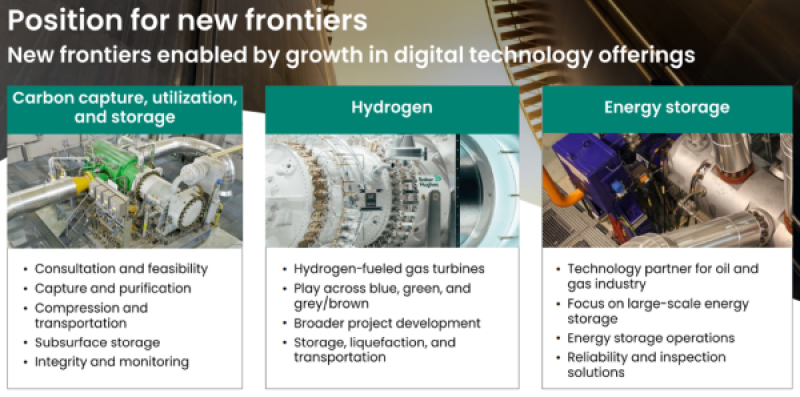Baker Hughes outlined its plan for transitioning to an energy technology company moving toward a low-carbon future and capitalizing on the changing energy landscape beyond its oil and gas oilfield services. During the Barclays Energy-Power Conference last month, CEO Lorenzo Simonelli said the company will continue to downsize its oilfield services (OFS) and equipment portfolio, emphasizing services for energy transition and technology for renewables.
At the start of 2019, the company said it would focus on emissions and reduce its carbon emissions by 50% by 2030, aiming for carbon net zero by 2050. Simonelli said it has reduced its carbon emissions by 31% compared to its 2012 baseline.
The company’s transition plan comes amid an uncertain outlook for global oil and gas markets in the near- to intermediate term due to factors impacting both supply and demand.
Excess capacity remains long as LNG cargo cancellations continue and the OPEC+ countries maintain their highest level of excess capacity in the past 20 years, while economic impact and potential behavioral changes from the COVID-19 pandemic are expected to drag down demand for the foreseeable future.
Market Uncertainty
“Given these dynamics, we are prepared for future volatility and remain cautious on the outlook for both global exploration and production spending and project final investment decisions in 2020 and likely 2021,” Simonelli said. “Looking beyond the current supply-demand imbalance, we believe the bigger story for the energy markets is the broader shift unfolding in energy investment and consumption patterns and its longer-term implications. “
He added the company is “particularly constructive” on natural gas and LNG, seeing it as transition fuel to a lower-carbon future. The company believes investment is required globally to maintain or modestly grow production levels in the future.
“As part of this strategy, we highlighted a planned shift in our portfolio over time to leverage our current technologies to grow further in the gas value chain, expand in the downstream segment, and increase our presence in industrial and chemical end markets,” Simonelli noted.
Adjusting Its Portfolio
The company recently agreed to sell noncore businesses. In May it announced the sale of its rod lift unit to private equity fund manager KPS Capital Partners, followed by the sale of its specialty polymers business announced in July to SK Capital Partners, a private investment firm.
In addition to divestitures, Baker Hughes shut down low-return and noncore product lines in the US such as full-service onshore drilling and completion fluids, cased-hole wireline, and frac-plug operations.
Houston-based private equity fund Pelican Energy Partners announced on 10 September its plans to buy Baker Hughes’ surface pressure control (SPC) flow business, which supplies tools and machinery for oil and gas drillers. The transaction is expected to close in Q4, and Baker Hughes will retain its SPC projects business in the Middle East, Africa, North Sea, and Asia.
Transforming the Core
Simonelli said transforming the core of the company includes multiple workstreams developed over the past year and initiatives to drive higher profitability and returns.

On the cost side, the company is executing a cost-reduction program across its product companies, targeting $700 million in annualized savings by year end.
“Given the pace of commoditization across some product lines, in order to achieve our return requirements, we intend to make additional rationalization efforts going forward,” Simonelli said. “These actions will be primarily focused on our OFS and OFE product companies and will consist of divesting or exiting noncore product lines or operations in certain geographies where the market structure may not allow for adequate returns.”
Simonelli added the company is evaluating new business models, intending to change the way it goes to market by exploring more direct sales and channel partner models in several products and geographies.
Investing for Growth
Simonelli said the primary growth opportunities within the company’s existing products include the industrial sector, chemicals, and nonmetallic materials. He sees opportunity to develop an industrial platform by leveraging core competencies within its Turbomachinery & Process Solutions (TPS) and Digital Solutions segments on the industrial side to deliver energy efficiency and process solutions.
It is also planning to build on its turbines, compressors, and valves to combine with its condition-monitoring technologies.
In the nonmetallic and chemicals sectors there is potential growth internationally in the downstream segment and into other specialty-chemicals markets. With new plants in Singapore and Saudi Arabia, Baker Hughes positioned its chemicals business for growth across the Middle East and Southeast Asia.
The 2018 acquisition of Polyflow expanded its capabilities in onshore flexible composite pipe and nonmetallic technologies. The recent joint venture agreement with Saudi Aramco to develop nonmetallic materials for oil and gas offers potential for expanded growth.
The company will also focus on artificial lift and production chemicals, remote operations, and artificial intelligence to provide production solutions.
A New Frontier
“Overall, we see a range of options for our technology but see the greatest potential in carbon capture, hydrogen, and energy storage,” said Simonelli.

The company’s exposure to the carbon capture, utilization, and storage (CCUS) value chain includes post-combustion capture, compression, subsurface storage, and long-term monitoring. It also believes it has the potential to participate in the hydrogen value chain.
The company is active in power generation, reconfiguring its NovaLT turbines to run on 100% hydrogen, and has completed testing with SNAM for a hybrid hydrogen turbine designed for natural gas transportation infrastructure. Its compression technology also has applications in hydrogen production in addition to storage, liquefaction, and transportation.
“Underpinning these new frontiers will be an increasing reliance on monitoring and digital technology,” Simonelli said. “Our goal is to utilize these capabilities to enable our products and services in these emerging areas. In addition to our partnership with C3.ai, we will focus on core digital technologies that will be critical to delivering high-efficiency and productivity solutions in areas such as remote operations and de-manning, edge computing, and additive manufacturing.”

